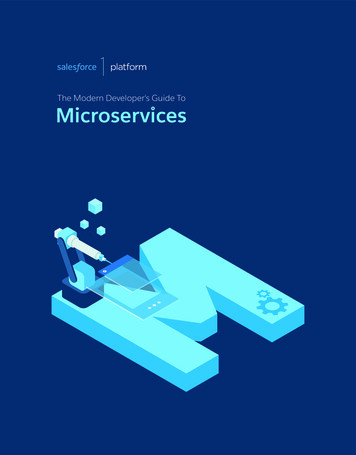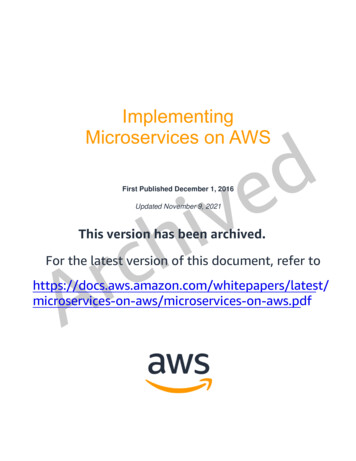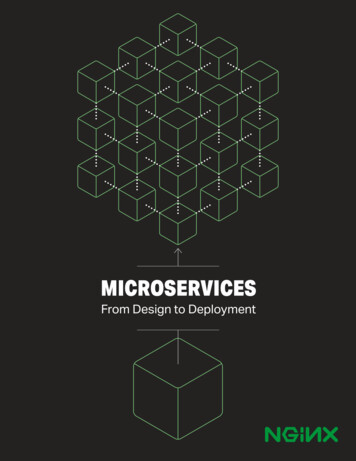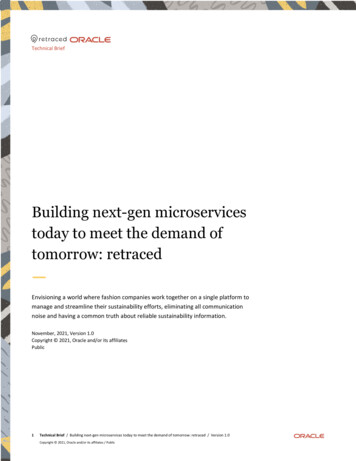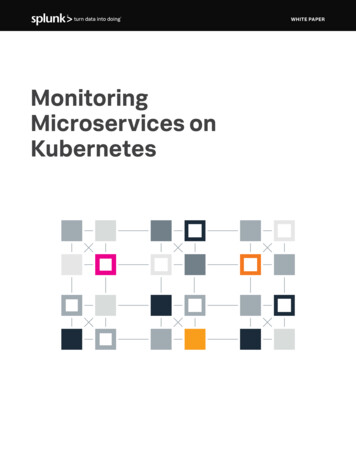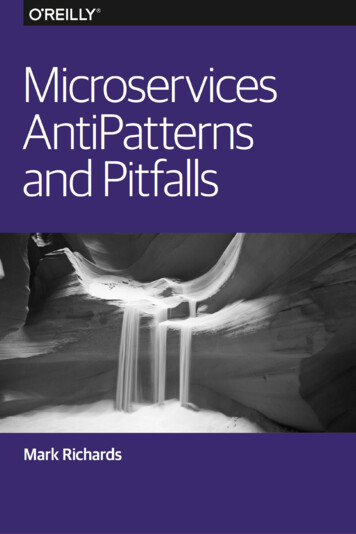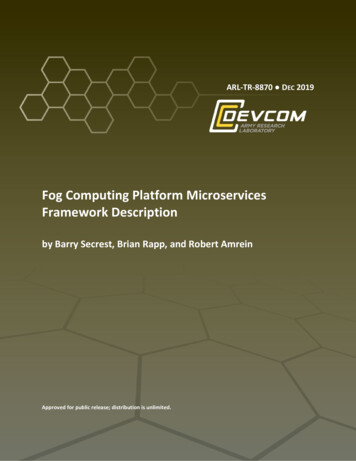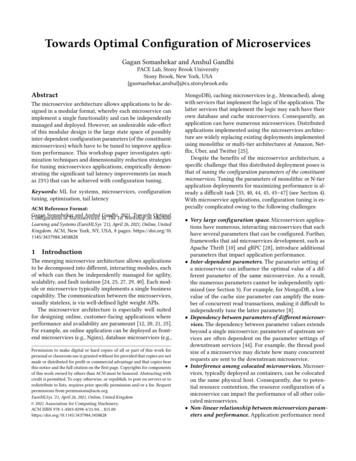
Transcription
Towards Optimal Configuration of MicroservicesGagan Somashekar and Anshul GandhiPACE Lab, Stony Brook UniversityStony Brook, New York, he microservice architecture allows applications to be designed in a modular format, whereby each microservice canimplement a single functionality and can be independentlymanaged and deployed. However, an undesirable side-effectof this modular design is the large state space of possiblyinter-dependent configuration parameters (of the constituentmicroservices) which have to be tuned to improve application performance. This workshop paper investigates optimization techniques and dimensionality reduction strategiesfor tuning microservices applications, empirically demonstrating the significant tail latency improvements (as muchas 23%) that can be achieved with configuration tuning.Keywords: ML for systems, microservices, configurationtuning, optimization, tail latencyACM Reference Format:Gagan Somashekar and Anshul Gandhi. 2021. Towards OptimalConfiguration of Microservices. In The 1st Workshop on MachineLearning and Systems (EuroMLSys ’21), April 26, 2021, Online, UnitedKingdom. ACM, New York, NY, USA, 8 pages. onThe emerging microservice architecture allows applicationsto be decomposed into different, interacting modules, eachof which can then be independently managed for agility,scalability, and fault isolation [24, 25, 27, 29, 40]. Each module or microservice typically implements a single businesscapability. The communication between the microservices,usually stateless, is via well-defined light weight APIs.The microservice architecture is especially well suitedfor designing online, customer-facing applications whereperformance and availability are paramount [12, 20, 21, 25].For example, an online application can be deployed as frontend microservices (e.g., Nginx), database microservices (e.g.,Permission to make digital or hard copies of all or part of this work forpersonal or classroom use is granted without fee provided that copies are notmade or distributed for profit or commercial advantage and that copies bearthis notice and the full citation on the first page. Copyrights for componentsof this work owned by others than ACM must be honored. Abstracting withcredit is permitted. To copy otherwise, or republish, to post on servers or toredistribute to lists, requires prior specific permission and/or a fee. Requestpermissions from permissions@acm.org.EuroMLSys ’21, April 26, 2021, Online, United Kingdom 2021 Association for Computing Machinery.ACM ISBN 978-1-4503-8298-4/21/04. . . B), caching microservices (e.g., Memcached), alongwith services that implement the logic of the application. Thelatter services that implement the logic may each have theirown database and cache microservices. Consequently, anapplication can have numerous microservices. Distributedapplications implemented using the microservices architecture are widely replacing existing deployments implementedusing monolithic or multi-tier architectures at Amazon, Netflix, Uber, and Twitter [25].Despite the benefits of the microservice architecture, aspecific challenge that this distributed deployment poses isthat of tuning the configuration parameters of the constituentmicroservices. Tuning the parameters of monolithic or N-tierapplication deployments for maximizing performance is already a difficult task [33, 40, 44, 45, 45–47] (see Section 4).With microservice applications, configuration tuning is especially complicated owing to the following challenges: Very large configuration space. Microservices applications have numerous, interacting microservices that eachhave several parameters that can be configured. Further,frameworks that aid microservices development, such asApache Thrift [10] and gRPC [28], introduce additionalparameters that impact application performance. Inter-dependent parameters. The parameter setting ofa microservice can influence the optimal value of a different parameter of the same microservice. As a result,the numerous parameters cannot be independently optimized (see Section 3). For example, for MongoDB, a lowvalue of the cache size parameter can amplify the number of concurrent read transactions, making it difficult toindependently tune the latter parameter [8]. Dependency between parameters of different microservices. The dependency between parameter values extendsbeyond a single microservice; parameters of upstream services are often dependent on the parameter settings ofdownstream services [44]. For example, the thread poolsize of a microservice may dictate how many concurrentrequests are sent to the downstream microservice. Interference among colocated microservices. Microservices, typically deployed as containers, can be colocatedon the same physical host. Consequently, due to potential resource contention, the resource configuration of amicroservice can impact the performance of all other colocated microservices. Non-linear relationship between microservices parameters and performance. Application performance need
EuroMLSys ’21, April 26, 2021, Online, United KingdomGagan Somashekar and Anshul Gandhimost likely to impact end-to-end application latency. As illustrated by the two rightmost bars in Figure 1, by employingdimensionality reduction, we can achieve roughly the sameimprovement in tail latency (0.2% difference) while only tuning about 43% of all microservices (roughly 57% reduction innumber of parameters tuned).This workshop paper makes the following contributions:Figure 1. Comparison of 95𝑡ℎ percentile of latency for thesocial networking application [25] under (i) default configuration values (Default), (ii) the configuration used by DeathStarBench benchmark developers [2] (DSB), and the configuration found by the best optimization technique among thosewe explored (iii) with dimensionality reduction (consideringonly a subset of microservices for tuning) and (iv) withoutany reduction (tuning all microservices).not be monotonically or linearly dependent on parametervalues, making it difficult to determine optimal configuration parameter settings. The thread pool size parameteris a classic example whereby a low value results in underutilization of the CPU and a very high value results incontention for network sockets or CPU resources [40].There is very little prior work on the specific problem ofconfiguration tuning of microservices, and that work relieson empirical analysis for the specific parameters of threadpool size and threading model [40]. There are, however, priorworks that focus on optimizing the configuration of individual services [19, 46], but as explained above, the dependencies between the parameters of microservices makes itinfeasible to optimize them in isolation. To the best of ourknowledge, there is no prior work that focuses on the problem of comprehensively tuning the configuration parametersof a microservice application.This workshop paper explores the problem of configuration tuning of microservices applications. We conduct anextensive experimental investigation of various black-boxoptimization algorithms with the goal of minimizing thetail latency of a given microservice application deployment.As shown in Figure 1, the best optimization algorithm canreduce the tail latency of the social networking microserviceapplication [25] by as much 23% and 21% compared to the default configuration setting and the suggested configurationin prior work [25], respectively.To address the key challenge of a large configuration spacewhen tuning microservices applications, we first identify potential performance-impacting parameters for popularly deployed microservices, such as Nginx, Memcached, MongoDB,etc. We then investigate various dimensionality reductionapproaches to identify a subset of microservices that are1. Problem formulation. We frame the configuration tuning problem as an optimization problem, making it amenableto optimization algorithms.2. Automated framework to aid the configuration optimization. We implement a framework to experimentallyexplore and evaluate the configuration space of parameters for microservices. The framework is fully automatedand can be integrated with any optimization technique.3. Experimental evaluation of different optimization algorithms. We implement six different representative optimization algorithms using open-sourced libraries andcompare their efficacy in choosing the best configurationwith respect to minimizing the application tail latency.To assess the optimization algorithms’ applicability inpractice, we also analyze their convergence and overhead.4. Dimensionality reduction. For scalability, we investigate techniques to reduce the overhead of optimizationalgorithms by limiting the set of microservices whoseparameters will be configured. We consider various subsets of microservices: (i) those on the critical path, (ii)those that cause performance variability, and (iii) thoseidentified by prior works to be performance bottlenecks.2Problem Formulation and System DesignIn this section, we formulate the microservices configurationsetting problem as an optimization problem. We then describe our system design for the automated framework thataids our experimental evaluation (presented in Section 3).2.1Microservices configuration setting problemLet 𝑓 (𝑐) denote the objective function (or performance metric) for the microservices application under the configuration𝑐; here, 𝑐 is the (potentially large) vector of parameter settings for all tunable parameters of all microservices. Let 𝐶denote the set of all configurations, i.e., all feasible valuesthat vector 𝑐 can take. Finally, let 𝑐𝑜𝑝𝑡 𝐶 denote the configuration that minimizes the performance metric, 𝑓 (). Thus,𝑐𝑜𝑝𝑡 argmin𝑐 𝐶 𝑓 (𝑐). We could consider metrics that needto be maximized by minimizing the negative of the objectivefunction. Our problem statement is to find 𝑐𝑜𝑝𝑡 or a nearoptimal configuration. We focus on the realistic case whereno assumptions can be made on the structure of 𝑓 () or onthe availability of offline training data. We further assert,for practical purposes, that the (near-)optimal configurationshould be determined in a reasonable amount of time.
Towards Optimal Configuration of MicroservicesApplication deployment fileExperiment detailsController1)c(i OptimizerEuroMLSys ’21, April 26, 2021, Online, United cker compose filesApplicationFigure 2. Illustration of our solution framework. 𝑓 () is objective function or performance metric of interest and 𝑐 (𝑖)is the configuration setting for iteration 𝑖.While 𝑓 () can represent any metric of interest, includingcombinations of metrics, we consider the 95𝑡ℎ percentile ofend-to-end application latency to be our metric, 𝑓 (). Wenote that customer-facing applications often employ suchtail latency metrics to assess application performance [21].Given the dependencies between parameters and the possible non-linear relationship between performance and parameter values (as described in Section 1), it is unlikely that𝑓 () can be determined or inferred accurately. Thus, classicconvex optimization techniques cannot be readily applied todetermine 𝑐𝑜𝑝𝑡 . However, for a given 𝑐, the value of 𝑓 (𝑐) canbe observed or measured by setting the parameter valuesin 𝑐 for the microservices and running an experiment. Thissuggests that black-box optimization techniques, that iteratively observe the value of 𝑓 () at a given 𝑐 and determinethe next configuration value 𝑐 ′ to explore, can be applied tofind 𝑐𝑜𝑝𝑡 or near-optimal 𝑐 values.2.2Automated framework to aid optimizationUnlike prior works [16, 19] that run optimization algorithmsover readily available datasets, we evaluate the value of theobjective function, 𝑓 (), by running an experiment. To streamline the iterative exploration of configurations (for determining 𝑐𝑜𝑝𝑡 ), we thus require a robust framework that can automatically: (i) configure the parameters of the microservicesas directed and run the application, (ii) collect the requiredmetrics, and (iii) run the optimization algorithm to obtainthe next configuration to experiment with. The frameworkshould also be application-agnostic and should allow theoptimization algorithm to be a pluggable module.Figure 2 illustrates the design of our automated frameworkthat we use to conduct our experiments. The application deployment file has the list of microservices, their images, thehost details, etc. The controller passes the value of the measured objective function, 𝑓 (𝑐 (𝑖)), of the current iteration, 𝑖,and queries the optimizer for the next configuration setting,𝑐 (𝑖 1). Using the details in the application deployment fileand the 𝑐 (𝑖 1) configuration passed by the optimizer, thecontroller generates docker-compose files on the fly with thenecessary network settings and mounts. The application isthen deployed on the servers using these docker-composefiles and the client sends the workload to the application.The request traces are collected by a tracing framework andthe latency metrics are calculated by the controller. Thesemetrics are passed to the controller which then calculates theobjective function, 𝑓 (𝑐 (𝑖 1)), and repeats the process iteratively until a good enough configuration is found or until anexploration time limit is reached. Our framework currentlysupports any linear combination of average, median, or taillatency for the objective function. The framework can beemployed for any microservices application by includingthe application deployment file for that application. Any optimization algorithm can be added by inheriting the Optimizerclass and implementing its methods.3EvaluationIn this section, we first discuss our experimental setup andmethodology, and then present our experimental results.3.1Experimental setupWe use a cluster with four servers, each with 24 (hyper)cores,40 GB of memory, and 250GB of disk space. We deploy themicroservices of the application on these servers based ontheir functionality: one server hosts front-end microservices,one hosts back-end microservices, one hosts the microservices that implement the logic, and one server is dedicatedfor monitoring the microservices and the application performance. We restrict monitoring services, Jaeger [4] withElasticsearch [3] back-end, to a different server to avoid interference with the application. docker-compose is used todeploy the application and overlay network connects themicroservices across the servers.We employ the social networking application from theDeathStarBench benchmark [25] to evaluate the efficacyof different black-box optimization algorithms. The socialnetworking application has 28 microservices that togetherimplement several features of real-world social networking applications. The constituent microservices are Nginx,Memcached, MongoDB, Redis, as well as microservices thatimplement the logic of the application. The application workload consists of 10% requests that create a post, 30% requeststhat read the user’s own timeline, and 60% requests thatread the timeline of other users; this division is based on anempirical estimate of a user’s typical behaviour.We change the type of server in the social networkingapplication of DeathStarBench to TNonblockingServer. TheApache Thrift C TNonblockingServer provides good performance and exposes numerous settings for the developerto customize the server [10]. We also make modifications tochange the thread pool size dynamically based on the valuesuggested by the optimizer for each iteration.3.2Evaluation methodologyFor evaluation, we consider the 95𝑡ℎ percentile of latency asthe performance metric; other latency metrics can be readilyused as well. For each microservice, we select at most fiveparameters to tune; we refer to product documentation [1, 5–7, 10] to identify the performance-impacting parameters. For
EuroMLSys ’21, April 26, 2021, Online, United Kingdomeach configuration to be tested, we run the application underthat configuration three times for a duration of 5 minuteseach, and collect latency metrics across all runs. We nextdiscuss the optimization algorithms and dimensionality reduction strategies we investigate in our evaluation.3.2.1 Black-box optimization algorithms. We consider6 optimization algorithms in our evaluation. The first 2 arerepresentative of heuristic-based probabilistic algorithms, thenext 2 are evolutionary algorithms inspired by populationbased biological evolution, and the last 2 are sequential modelbased optimization algorithms that approximate the objective function with a cheaper, surrogate function [13] to aidoptimization. We use skopt [9], Hyperopt [14], and Nevergrad [38] libraries to implement the algorithms.1. Simulated Annealing (SA) [36] starts with an initial configuration, 𝑐 0 , and at each iteration considers a neighbouring configuration, 𝑐𝑛 . It then picks the next configurationbased on the value of the objective function at 𝑐 0 and 𝑐𝑛and a time varying parameter, 𝑇 , whose value slowly decreases (annealing) with each iteration leading to moreexploitation and less exploration.2. Dynamically Dimensioned Search (DDS) starts with aninitial configuration and then perturbs the values of theparameters of the configuration based on a perturbationfactor [42]. The algorithm moves from a global searchtowards a local search as the iterations progress by dynamically and probabilistically reducing the number ofparameters that are perturbed.3. Particle Swarm Optimization (PSO) [32] works by iteratively improving the candidate solution with regard tothe objective function. Each candidate solution is knownas a particle and all particles together form a swarm. Theparticles are moved around the search-space based on thebest value the particle has seen so far (exploration) and theglobal best value seen by the whole swarm (exploitation).4. Genetic Algorithms (GA) [34] start with an initial random population of candidate configurations which is thenpruned based on the value of the objective function atthese configurations. This pruned subset is used to generate a new set of candidates through mutation (randomlychanging the configurations of some parameters) andcrossover (combining configurations of the candidates).5. Bayesian Optimization (BO) starts with a prior distribution of the search space guided by the surrogate; weexperiment with the popular Gaussian Process (GP) [13],Gradient Boosted Regression Trees (GBRT) [22], and Random Forests (RF) [23] surrogate models. The posteriordistribution is updated at each step of exploration usingBayesian method.6. Tree-structured Parzen Estimator (TPE) is similar toBO, but models the likelihood and prior instead of theposterior [13].Gagan Somashekar and Anshul Gandhi3.2.2 Dimensionality reduction strategies. If an application has 𝑚 microservices each with 𝑝𝑖 parameters (for𝑖 1, 2, . . . , 𝑚), then theÍ number of dimensions in a configuration vector 𝑐 is 𝑛 𝑚𝑖 1 𝑝𝑖 . For the purpose of illustration,if each parameter can take 𝑣 different values, then the number of possible configurations is 𝐶 𝑣 𝑛 . Clearly, the searchspace of configurations grows exponentially with the number of microservices. To reduce the search space, we thusconsider strategies that allow us to focus our configurationtuning effort on only a subset of the microservices. Anotheradvantage of dimensionality reduction is that not all optimization algorithms work well in high dimensions (numberof tunable parameters, in our case), for example, BayesianOptimization (BO) is known to not perform well when thenumber of parameters to optimize is more than 20 [35].1. Critical path. In the call graph of a request, the critical path is the path formed by microservices that determines the latency of the request. We employ standardpractices [37] to determine the critical path of a requestand only consider configuration tuning for these microservices. We rely on the service time (or span) measurementsprovided by Jaeger for each microservice to determinethe critical path. We also exclude all microservices on thecritical path whose service time is less than 1ms; we findthat such microservices do not contribute significantly tolatency and can be omitted to reduce the configurationsearch space (by as much as 33% in our experiments).2. Known bottlenecks. Prior work on performance diagnosis of microservices applications conducted thorough empirical analysis to identify performance bottlenecks [26].We thus investigate configuration tuning only for the 8bottleneck microservices identified by these works. Sincethis approach requires prior knowledge of bottlenecks, weconsider it an unrealistic approach but one that serves asground truth for comparison.3. Performance variance. Prior works [20, 39, 41] demonstrated the improvement in performance that can be obtained by redesigning components that cause high performance variability. Inspired by this approach, we considerconfiguration tuning only for the 7 microservices thathave a significant service time coefficient of variation [17](above 0.5 in our experiments).3.3Experimental resultsIn practice, the optimization algorithms cannot be run indefinitely. Unless otherwise specified, we thus limit the number of configurations to be explored for each optimizationalgorithm to 15. For initialization, the optimization algorithms typically start with a random configuration. Notethat (re)setting the configuration parameters between iterations does incur some overhead and may require restartingsome microservices; during this time, the application maybe momentarily offline.
Towards Optimal Configuration of MicroservicesFigure 3. Evaluation of different dimensionality reductiontechniques with respect to improvement in latency over thedefault configuration under DDS and Bayesian optimization.Efficacy of dimensionality reduction. Figure 3 shows thepercentage improvement in tail (95𝑡ℎ percentile) latency ofthe social networking application under different dimensionality reduction techniques, compared to the tail latencywhen using the default configuration for all parameters. Forease of illustration, we show the results for two specificoptimization algorithms. We see that tuning all 28 microservices of the social networking application provides about25% improvement in tail latency. However, tuning only themicroservices on the critical path (12 microservices) provides22–23% improvement. Tuning the known bottlenecks provides similar improvements, suggesting that the critical pathapproach correctly identifies the microservices that havethe most impact; note that the known bottlenecks approachrequires prior, offline knowledge of bottlenecks, which isnot always feasible and requires significant additional effort.Finally, by focusing on the variability causing microservices,the afforded improvement in latency is about 17–20%.To further contrast the three different dimensionality reduction techniques, we consider the overlap in subsets ofmicroservices chosen by the techniques. We find that onlytwo microservices are common among all the subsets: (i)post-storage-memcached is an important microservice as itcaches posts that are read by requests that constitute 90%of the workload; and (ii) compose-post-service is critical inthe call graph of the request that writes posts as it is calledmultiple times per request. This shows that, despite differences in the subsets, all three techniques have the ability toidentify important, performance-impacting microservices.Performance of different optimization algorithms. Thebars in Figure 4 show the (sorted) percentage improvement(on left y-axis) in tail latency over the default configurationafforded by different optimization algorithms using the critical path approach. For comparison, we also show (as DSB)the improvement afforded (about 3%) by the configurationemployed by the DeathStarBench benchmark developers [2].We see that DDS provides the best improvement of 23.4%,followed closely by PSO (22.9%) and BO (22.1%). We noteEuroMLSys ’21, April 26, 2021, Online, United KingdomFigure 4. Comparison of improvement in latency comparedto default configuration (left y-axis) and the time incurredby the optimization (right y-axis) for all algorithms whentuning the microservices on the critical path.that for Bayesian Optimization, we experimented with various surrogate models; we found Gaussian Process (with theExpected Improvement acquisition function), referred to asBO GP in our figures, to provide the best results.We also show with Serial the performance improvementafforded by the approach that sequentially tunes (using BOGP) each microservice on the critical path, as opposed tojointly tuning all microservices on the critical path. The Serial approach is similar to one of the baselines proposed inVanir [15] for the cloud resource allocation problem (seeSection 4). We find that Serial provides about 18.9% improvement, suggesting that independently tuning microservicescan be sub-optimal. Further, we find that the order of optimization is also important for Serial; when sequentiallyoptimizing microservices in the reverse order of the criticalpath, the percentage improvement is better.To evaluate the overhead of different optimization algorithms, we plot (solid line with right y-axis) the time taken bythe optimization across all iterations in Figure 4. We find thatDDS requires the least amount of time (7ms), followed byBO (1.4s) and PSO (2.2s). SA and TPE incur a high overhead.Serial employs BO but takes a significant amount of time(9.3s) because it involves tuning each of the 12 microserviceson the critical path sequentially with 15 iterations each.Based on the above results, we conclude that, for our evaluation, DDS is the best performing optimization algorithm.An additional advantage of DDS is that it is designed foroptimizing in high dimensions [42], making it suitable forenterprise applications that are composed of a large numberof microservices.Analysis of best configurations chosen by all the algorithms. As seen in Figure 4, different optimization algorithms provide comparable latency benefits. An importantquestion in this context is whether the different algorithmsare converging to the same globally optimal or differentlocally optimal configurations. Interestingly, we find thatthe best configuration chosen by different algorithms is indeed different. However, we do see some similarities anddifferences in the parameter settings in these configurations. The default memory limit value for Memcached is
EuroMLSys ’21, April 26, 2021, Online, United KingdomGagan Somashekar and Anshul Gandhi4Figure 5. Comparison of tuning efficiency for the top 3 algorithms for 15 iterations when tuning on the critical path.64MB; however, the best configurations suggested by thealgorithms have a memory limit value of at least 4GB for thepost-storage-memcached microservice. The threading and execution model in MongoDB is synchronous by default, but thebest performing algorithm, DDS, sets this parameter to adaptive for all the MongoDB microservices on the critical path,suggesting that adaptive is a better option. Similarly, DDSsets the number of threads in write-home-timeline-service to18, which is higher than the setting assigned by other algorithms, enabling it to exploit the host’s processing power.Convergence analysis of algorithms. The results shownin Figure 4 are based on the best configuration picked by thealgorithms from among 15 iterations. To analyze the significance of number of iterations, we plot the best improvementafforded until different iterations for the top 3 algorithms inFigure 5. We see that DDS quickly finds good configurationsas compared to BO and PSO. We also analyzed the resultsfor 100 iterations and found that the additional performancebenefit afforded over 15 iterations is only about 1–2% compared to the best solution in Figure 4, suggesting that theoptimization algorithms converge relatively quickly. Thisis a useful feature in practice given that each additional iteration imposes certain overhead and unavailability on theapplication.Significance of initial configuration. The optimizationalgorithms typically start with a randomly sampled configuration. To assess the significance of this initial configurationon performance improvement and convergence, we specifically set the initial configuration to one that we know performs poorly to check how the optimization recovers; weuse BO GP for this evaluation. For example, we limit thenumber of processes for the Nginx microservice to 1, set theMemcached cache size to 16MB, etc. We find that, despitethe poor initial configuration, the algorithm does providesignificant improvement over the default configuration, withonly a 3.4% relative drop in performance compared to therandomly chosen initial configuration case.Related WorkMicroservices configuration tuning. 𝜇Tune [40] is a framework that reduces the tail latency of On-Line Data Intensive(OLDI) applications implemented as microservices. 𝜇Tunebuilds empirically-derived piece-wise linear models for different threading models and thread pool sizes at variousloads, which then guides the online tuning stage. However,as discussed in Section 3.3, microservices have numerousother parameters that can impact performance.Application configuration tuning. There has been considerable research in parameter tuning for individual applications, such as Apache web server [44], Memcached [43],database [46] and storage systems [19], etc. While the aboveworks can be used to tune individual microservices in isolation, the dependencies between microservices necessitatesglobal optimization across microservices.SmartConf [45] is a control-theoretic framework that automatically sets and dynamically adjusts parameters of software systems to optimiz
microservices) which have to be tuned to improve applica-tion performance. This workshop paper investigates opti-mization techniques and dimensionality reduction strategies for tuning microservices applications, empirically demon-strating the significant tail latency improvements (as muc
